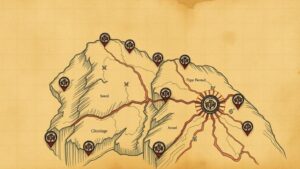Detecting for Relics Around Sunken Treasure Galleons
Detecting for Relics Around Sunken Treasure Galleons
The allure of sunken treasure galleons has captivated the imaginations of treasure hunters, historians, and archaeologists alike. These vessels, often laden with gold, silver, and other valuables, tell tales of exploration, trade, and the perils of the sea. The process of detecting for relics around these galleons, however, involves sophisticated methodologies that combine advanced technology with historical research. This article delves into the various techniques employed in the detection of relics, the significance of historical context, and practical applications in the field of underwater archaeology.
The Historical Context of Sunken Treasure Galleons
To effectively detect relics around sunken treasure galleons, understanding their historical context is crucial. Many of these ships sank during the 16th to 18th centuries due to storms, naval warfare, or navigational errors. The Spanish galleons, for example, were part of the “Spanish Treasure Fleet” that transported riches from the Americas to Europe. According to the National Oceanic and Atmospheric Administration (NOAA), nearly 260 Spanish galleons are believed to have sunk in the Caribbean alone, each potentially containing artifacts of immense historical value.
Modern Detection Techniques
Several advanced techniques are available for detecting relics around sunken treasure galleons. Each method has its strengths and limitations, and a combination of technologies is often employed to maximize the chances of a successful recovery.
- Sonar Imaging: Side-scan sonar is one of the most common tools used in underwater treasure hunting. It emits sonar waves that bounce off the seabed, creating detailed, two-dimensional images of the ocean floor. This method allows treasure hunters to locate the contours and structures of sunken galleons. The 2014 discovery of the Spanish galleon San José off the coast of Colombia utilized side-scan sonar technology to locate the ship, which was carrying an estimated $17 billion in treasure.
- Magnetometry: This technique involves measuring variations in the Earth’s magnetic field caused by metallic objects underwater. Magnetometers can detect ferrous metals like iron and steel, which are prevalent in ships. For example, the exploration of the wreck of the Titanic involved magnetometry to identify potential debris fields that could include artifacts.
- Underwater Drones: Remotely Operated Vehicles (ROVs) equipped with cameras and tools can explore deep-sea wreck sites, providing real-time visuals and data. The use of ROVs offers researchers the chance to inspect delicate artifacts without physical interference, preserving their condition. The recovery of artifacts from a World War II shipwreck off the coast of South Carolina exemplifies the use of ROVs in both treasure hunting and historical research.
Interdisciplinary Collaboration
Successful relic detection is rarely the work of a single discipline. It often requires a collaborative effort among various fields such as archaeology, maritime history, and oceanography. For example, researchers may collaborate with historians to identify likely galleon sites based on historical shipping routes and shipwreck records. This multidisciplinary approach ensures that not only are artifacts recovered, but they are also appropriately contextualized and preserved for future generations.
Legal and Ethical Considerations
When detecting relics around sunken treasure galleons, legal and ethical concerns arise, especially regarding ownership and conservation. Many countries have laws governing the wrecks located within their waters, which can complicate treasure hunting operations. For example, the UNESCO Convention on the Means of Prohibiting and Preventing the Illicit Import, Export, and Transfer of Ownership of Cultural Property establishes regulations to protect underwater heritage sites from looting. Ethical considerations also dictate that recovery teams prioritize the preservation of artifacts in situ whenever possible, rather than extracting them solely for commercial profit.
Case Studies: Successful Discoveries
Numerous case studies illustrate the effectiveness of detection techniques for uncovering relics. One notable example is the discovery of the Atocha, a Spanish galleon that sank off the Florida Keys in 1622. Treasure hunter Mel Fisher used a combination of shipwreck maps, historical records, and advanced sonar technology to locate the wreck site, ultimately recovering over $450 million in treasure. This case not only highlights the successful application of modern technology but also emphasizes the importance of diligent historical research.
Another example involves the HMS Sussex, a British warship that sank in 1694. ship was located using side-scan sonar technology after extensive collaboration among historians, maritime archaeologists, and governmental entities. Recovered artifacts provided invaluable insight into 17th-century naval warfare and trade practices.
Conclusion
The detection of relics around sunken treasure galleons requires a blend of innovative technology, historical insight, and ethical considerations. As techniques continue to evolve, the potential for uncovering lost treasures expands significantly. Researchers and treasure hunters alike are called to approach their endeavors with a commitment to preserving maritime heritage while also satisfying the thirst for exploration and discovery.
For those interested in engaging with this field, it is highly recommended to stay informed about advances in detection technology, collaboration opportunities with academic institutions, and the ever-evolving legal framework surrounding underwater archaeology.

